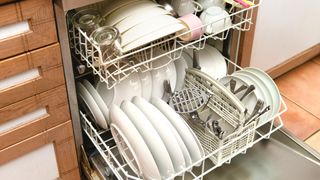Making sure your dishwasher is correctly running is also important to ensure its longevity. The easiest way to make your appliance last is to regularly clean it, and as most manufacturer warranties only cover your first year of use, it’s in your interest to keep it in its best shape. Before cleaning, always familiarize yourself with the manufacturer guidelines specific to your dishwasher to avoid any damage.
Quick tips to keep the inside of your dishwasher clean
There are easy, preventative measures you can take to stop food build-up, the enemy of dishwashers. Giving your plates a rinse before stacking them is one way to stop the appliance from becoming a home for your leftovers. Or if you don’t want to rinse, removing large pieces of food from the racks after washing will also prevent that same food will end up accompanying your dishes on their next wash. Wiping down any grimy or greasy looking surfaces under the bottom rack of your dishwasher will only take a minute, but will vastly improve how clean your kitchenware is when it emerges from the dishwasher. You can do this with a damp cloth, using antibacterial spray, or cleaning vinegar to remove any dirt. Make sure you wipe down any edges between the inner and outer of the machine too, as these may go unattended otherwise.
How to deep clean the inside of your dishwasher
In the long term, it’s advisable to deep clean your dishwasher every month or so. In order to do this, you’ll need to get to grips with the inside of your dishwasher to access the functional parts. Always make sure to have the manufacturer’s guide to refer to before doing this, and check any given instructions thoroughly, as wrongly replacing these parts could result in your dishwasher not functioning properly. Begin your clean by removing the dishwasher’s bottom rack. Here you’ll find your machine’s filter and sprayers. Ultimately, if the filter of your machine isn’t free from dirt, then your resulting wash cycles won’t be either. Similarly, the spraying mechanism which rotates at the bottom of the machine is where your detergent is dispensed; if these holes are blocked by food, then there will be less product being distributed altogether. You should be able to unlock these from the bottom of the machine by simply twisting and lifting them out. You’ll want to give all of these parts a long rinse with warm water until the nasty food residue is gone. If you haven’t cleaned your machine in a long time, the build-up of gunk may be quite severe and you’ll need to pay closer attention. Try using a toothbrush to gently clean the mesh surfaces of the filter and scrape the excess foodstuff away. Some filters have covered exteriors and don’t allow for thorough access inside. If this is the case, consider investing in a set of cleaning brushes (opens in new tab) to really do the job. After this, if you still find stubborn dirt stuck inside the filter, use tweezers to gently prise them out. Once you have the filter, spray jet arms and adjoining parts looking fresh, return them to your dishwasher as per the manual’s instructions. Cleaning your filter regularly does wonders for your dishwasher and means it’ll need less maintenance in the long run. Once you know how, the process of emptying the filter of any dirt is easy, so try and do it as often as you can. The next step in deep cleaning your appliance is to run your machine on a cleaning cycle. It’s best to do this with an empty machine, but if you do want to clean dishes at the same, just be aware of the cleaning products you’re using on your kitchenware and whether they are compatible. There are various products you can use to achieve a deep clean. If you don’t want to spend any extra cash, you can source products like apple cider vinegar or distilled white wine vinegar from home. Simply place a cup of whichever of these you have available onto the top rack, with a cup of baking soda dispensed into the bottom of your machine. Alternatively, if you want to pop a tablet in the dishwasher with no hassle, there are lots of different products (opens in new tab) available designed for intensive cleaning. If you’re lucky enough to have a machine with a cleaning program built-in, then simply select it to run after you’ve inserted your chosen products. Don’t worry if you don’t have a designated cleaning setting, as running the hottest and longest cycle possible will have the same effect. When it’s done, the inside of your dishwasher will be looking, smelling and operating in an altogether better condition. There are plenty of other things you can sanitize (opens in new tab) in your dishwasher too once you’ve tackled the cleaning itself.
How to deep clean the outside of your dishwasher
Most dishwashers have stainless steel exteriors. And though it won’t change the running of your machine, paying some attention to the outside of your dishwasher will keep your whole kitchen gleaming. Get stuck in with a suitable stainless steel cleaner (opens in new tab), using a microfiber cloth to wipe away any surface dirt or fingerprints. Make sure to wipe down the surface in the direction of the steel’s grain; for example, if the grain is from side to side then you’ll want to wipe in a side to side motion too. This will help avoid streaks. You don’t want to use a scourer or abrasive pad for the front of your washer, as it may damage the machine’s finish.
Today’s best dishwasher deals


